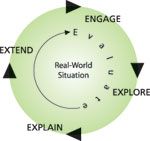My Cart
Your Shopping Cart is currently empty. Use Quick Order or Search to quickly add items to your order!
Inquiries in Science™ is an innovative series of hands-on kits that help high school students learn science essentials through guided inquiry. The lab activities and supplies included in each kit facilitate this guided-inquiry approach, providing a rich learning environment for students and effective, easy-to-use instructional resources for teachers. The following activity is included in the Sustaining Ecosystems Kit, which is part of the Inquiries in Science™ Environmental Science Series. It illustrates the Inquiries in Science™ learning cycle of engage, explore, explain, extend, and evaluate.

Ask your students to consider the following questions:
Have students create a mini-ecosystem using a large plastic container and lid, a small plastic container, aquarium gravel,
a cotton wick, a freshwater aquatic plant, 2 or 3 freshwater snails, conditioned water, potting soil, seeds, and the following
instructions.
Note: Container capacities are unspecified so you can use what you have on hand. Scrounge, recycle, be creative, have fun!
Place the mini-ecosystem in a sunny window or under a grow light. The only maintenance your ecosystem may require is replenishing the water in the bottom container by watering the soil in the top container. (The water will drip into the bottom container via the wick.)
Observe your ecosystem each day. Describe the interaction between the organisms in this ecosystem. How are they dependent on each other? What role does each play in the ecosystem? How does this model mini-ecosystem help in understanding ecosystems in general?

Help confirm your students’ grasp of the science concept throughout the activity. Make sure they can apply the concept of ecosystems to other real-world situations.
We hope this brief activity (just one of many in the kit) has given you a glimpse of how the Inquiries in Science™ learning cycle works and has heightened your interest in this new line of kits, especially the Environmental Science Series. Inquiries in Science™ also includes a Biology Series and a Chemistry Series. For more information, visit us online at www.carolina.com/inquiries or see our latest Carolina™ Science catalog. If you’d like to talk about implementing Inquiries in Science™ in your classroom, email Jen Black at melissa.hodges@carolina.com or phone her at 336.538.6355.
In this exploration of ecosystems, students begin by individually observing different biotic parts (including plants, animals, and decomposers) of an ecosystem they model. From these observations, students determine specific biotic and abiotic factors needed for a functioning ecosystem. Applying this knowledge, students work together to construct a complete ecosystem and build a new model. Kit includes lab supplies (enough for at least 30 students working in groups) plus teacher’s manual. Kit Refill replenishes all perishable materials; price includes shipping and handling.
Note: Order the Kit Refill with the perishable materials included or with a prepaid coupon to request the perishables later at your convenience. Contact us or return the coupon at least 2 weeks prior to requested delivery date to ensure prompt arrival of materials.